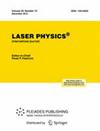Laser speckle-based estimation of surface condition for designing quieter material
IF 1.2
4区 物理与天体物理
Q4 OPTICS
引用次数: 0
Abstract
Laser speckle is a non-contact, non-interfering, non-destructive, rapid and controllable technique with a large area of coverage that has attracted much attention for surface analysis of materials. The emergence of different natural cellulosic materials as potential candidates for the replacement of synthetic ones is promising, but their sustainability from the point of view of material design is still in question. Machining of the surface of cellulosic components for making sound-dampening materials has a critical effect on determining their surface condition. Laser speckle is an emerging tool for surface analysis of a variety of materials, and it has important applications in material design and analysis. As a cutting-edge research tool, ultrasonic wave technology has maintained a significant contribution to the design and structural monitoring of composite materials. The present work uses date palm leaf fibers for composite reinforcement. The sound-dampening properties, such as sound absorption and transmission, were analyzed on the basis of surface roughness observed with the laser speckle technique and modified by ultrasonically blended surfactants. The surface roughness of the synthesized material was found to increase with sonication time with an基于激光斑点的表面状况估算,用于设计更安静的材料
激光斑点仪是一种非接触、无干扰、无损、快速和可控的大面积覆盖技术,在材料表面分析方面备受关注。作为替代合成材料的潜在候选材料,各种天然纤维素材料的出现令人充满希望,但从材料设计的角度来看,它们的可持续性仍然存在问题。对用于制造消音材料的纤维素部件进行表面加工,对确定其表面状况有着至关重要的影响。激光斑点是对各种材料进行表面分析的新兴工具,在材料设计和分析中有着重要的应用。作为一种前沿研究工具,超声波技术在复合材料的设计和结构监测方面做出了重大贡献。本研究采用枣椰叶纤维进行复合材料加固。根据激光斑点技术观察到的表面粗糙度分析了其吸声和透声等消声性能,并通过超声混合表面活性剂对其进行了改性。结果发现,合成材料的表面粗糙度随超声时间的延长而增加,R2 值为 0.944,并且观察到材料表面粗糙度数据的波动。材料的吸声系数为 0.98,透声损失为 60 dB,因此被归类为 ASTM E1050 A 级声学材料。此外,基于激光斑点的粗糙度估算方法被认为是设计任何类型低噪音材料的潜在工具。
本文章由计算机程序翻译,如有差异,请以英文原文为准。
求助全文
约1分钟内获得全文
求助全文
来源期刊

Laser Physics
物理-光学
CiteScore
2.60
自引率
8.30%
发文量
127
审稿时长
2.2 months
期刊介绍:
Laser Physics offers a comprehensive view of theoretical and experimental laser research and applications. Articles cover every aspect of modern laser physics and quantum electronics, emphasizing physical effects in various media (solid, gaseous, liquid) leading to the generation of laser radiation; peculiarities of propagation of laser radiation; problems involving impact of laser radiation on various substances and the emerging physical effects, including coherent ones; the applied use of lasers and laser spectroscopy; the processing and storage of information; and more.
The full list of subject areas covered is as follows:
-physics of lasers-
fibre optics and fibre lasers-
quantum optics and quantum information science-
ultrafast optics and strong-field physics-
nonlinear optics-
physics of cold trapped atoms-
laser methods in chemistry, biology, medicine and ecology-
laser spectroscopy-
novel laser materials and lasers-
optics of nanomaterials-
interaction of laser radiation with matter-
laser interaction with solids-
photonics
 求助内容:
求助内容: 应助结果提醒方式:
应助结果提醒方式:


